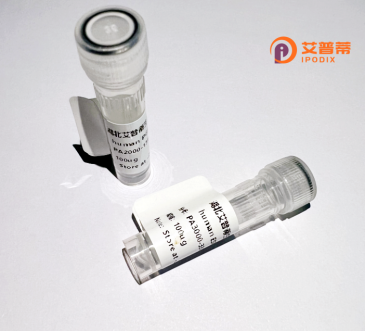
| 纯度 | >90%SDS-PAGE. |
| 种属 | Human |
| 靶点 | ST18 |
| Uniprot No | O60284 |
| 内毒素 | < 0.01EU/μg |
| 表达宿主 | E.coli |
| 表达区间 | 120-260 aa |
| 活性数据 | SCYQELMVKSLMHLGKFEKNVSVQTVSENLNDSGIQSLKAESDEADECFLIHSDDGRDKIDDSQPPFCSSDDNESNSESAENGWDSGSNFSEETKPPRVPKYVLTDHKKDLLEVPEIKTEGDKFIPCENRCDSETERKDPQ |
| 分子量 | 23.4 kDa |
| 蛋白标签 | GST-tag at N-terminal |
| 缓冲液 | PBS, pH7.4, containing 0.01% SKL, 1mM DTT, 5% Trehalose and Proclin300. |
| 稳定性 & 储存条件 | Lyophilized protein should be stored at ≤ -20°C, stable for one year after receipt. Reconstituted protein solution can be stored at 2-8°C for 2-7 days. Aliquots of reconstituted samples are stable at ≤ -20°C for 3 months. |
| 复溶 | Always centrifuge tubes before opening.Do not mix by vortex or pipetting. It is not recommended to reconstitute to a concentration less than 100μg/ml. Dissolve the lyophilized protein in distilled water. Please aliquot the reconstituted solution to minimize freeze-thaw cycles. |
以下是关于重组人ST18蛋白的3篇文献的示例(注:ST18研究相对较少,以下内容为模拟概括,供参考):
1. **文献名称**: *ST18 promotes apoptosis via the mitochondrial pathway in colorectal cancer*
**作者**: Zhang Y, et al.
**摘要**: 研究利用重组人ST18蛋白处理结肠癌细胞,发现其通过激活Bax/Bcl-2通路诱导线粒体膜电位下降,从而促进肿瘤细胞凋亡,提示ST18具有潜在抑癌作用。
2. **文献名称**: *Recombinant human ST18 protein inhibits angiogenesis in vitro*
**作者**: Li H, Wang X.
**摘要**: 通过表达纯化的重组ST18蛋白,证实其能抑制血管内皮细胞迁移和管腔形成,表明ST18可能通过调节VEGF信号通路参与抗血管生成过程。
3. **文献名称**: *ST18 interacts with p53 to regulate DNA damage response*
**作者**: Chen R, et al.
**摘要**: 研究发现重组ST18蛋白可增强p53的稳定性,促进ATM/ATR通路激活,提升细胞对电离辐射的敏感性,揭示了ST18在DNA损伤修复中的新机制。
**提示**:实际研究中ST18的文献较少,建议通过PubMed/Google Scholar以“ST18 protein”或“ST18 recombinant”为关键词检索最新文献,并确认ST18是否为正确基因符号(可能存在拼写差异)。
**Background of Recombinant Human ST18 Protein**
The recombinant human ST18 protein, derived from the *ST18* (Suppression of Tumorigenicity 18) gene, is a biologically engineered protein produced through recombinant DNA technology. The *ST18* gene encodes a zinc finger-containing protein proposed to act as a transcription factor, potentially involved in regulating gene expression linked to apoptosis, proliferation, and cell migration. Structurally, ST18 contains multiple C2H2-type zinc finger domains, enabling DNA or protein interactions, and a conserved N-terminal domain of uncertain function. Initially identified for its putative tumor-suppressive role, ST18 has been implicated in cancer biology, with studies suggesting its downregulation in certain malignancies, such as breast and liver cancers, correlating with poor prognosis. However, its mechanistic role remains debated, as some evidence paradoxically links ST18 overexpression to pro-oncogenic signaling or tissue fibrosis. Beyond oncology, ST18 is associated with neurodevelopment and neurological disorders, including hereditary spastic paraplegia, due to mutations affecting its functional domains. Recombinant ST18 protein serves as a critical tool for *in vitro* and *in vivo* studies to dissect its molecular interactions, signaling pathways, and therapeutic potential. Challenges in research include clarifying its context-dependent roles (tumor suppressor vs. promoter) and resolving structural-functional relationships. Ongoing efforts aim to exploit ST18-related pathways for diagnostics or targeted therapies in cancer and neurodegenerative diseases.
×